Click on images to enlarge
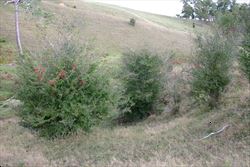
infestation (Photo: Trevor James)
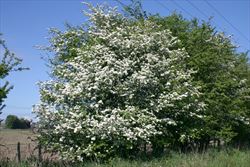
habit in flower (Photo: Trevor James)
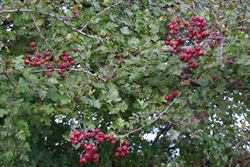
habit in fruit (Photo: Trevor James)
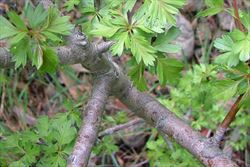
greyish older branches (Photo: Sheldon Navie)

younger branches and spines (Photo: Sheldon Navie)

young shoots and leaves (Photo: Sheldon Navie)
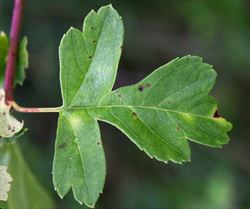
close-up of deeply-lobed leaf (Photo: Trevor James)
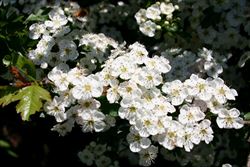
flower clusters (Photo: Trevor James)
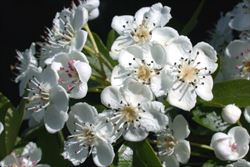
close-up of flowers (Photo: Rob and Fiona Richardson)
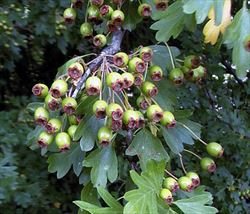
immature fruit (Photo: Greg Jordan)
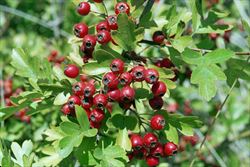
clusters of mature fruit (Photo: Rob and Fiona Richardson)
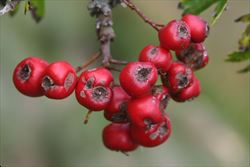
close-up of mature fruit (Photo: Trevor James)
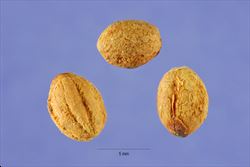
close-up of seeds (Photo: Steve Hurst at USDA PLANTS Database)
Scientific Name
Crataegus monogyna Jacq.
Synonyms
Mespilus monogyna (Jacq.) All.
Family
Malaceae (New South Wales)Rosaceae (Queensland, the ACT, Victoria, Tasmania, South Australia and Western Australia)
Common Names
English hawthorn, hawthorn, may, may thorn, Neapolitan medlar, oneseed hawthorn, one-seeded hawthorn, quickthorn, red hawthorn, single seeded hawthorn, singleseed hawthorn, single-seed hawthorn, thorn-apple, whitethorn
Origin
This species is native to northern Africa (i.e. northern Algeria, Morocco and Tunisia), Europe (i.e. Denmark, southern Finland, Ireland, southern Norway, southern Sweden, UK, Austria, Belgium, Czechoslovakia, Germany, Hungary, the Netherlands, Poland, Switzerland, Estonia, Ukraine, Albania, Bulgaria, Greece, Italy, Romania, Yugoslavia, France, Portugal and Spain) and western Asia.
Cultivation
A common garden ornamental that has been widely grown throughout southern Australia, particularly as a hedging plant. Numerous hybrids and cultivars, that have been developed by the nursery trade, can also be found in cultivation.
Naturalised Distribution
A very widespread species that is mainly naturalised in the south-eastern parts of Australia. It is most common and widespread in Tasmania, Victoria, the ACT and southern and central New South Wales. Also scattered in south-eastern South Australia, north-eastern New South Wales and south-eastern Queensland.
Naturalised overseas in southern Africa, New Zealand, USA (including Alsaka) and Canada.
Habitat
Mostly a weed of coastal and sub-coastal temperate regions that forms thickets along roadsides and waterways, in grasslands and open woodlands and along the margins of closed forests. It also infests old gardens, disturbed sites, waste areas and pastures.
Habit
An upright (i.e. erect) shrub usually growing 2-4 m tall, or occasionally a small tree reaching up to 10 m in height. It loses its leaves during winter (i.e. it is deciduous).
Distinguishing Features
- an upright and thorny shrub or small tree (usually 2-4 m tall) that loses its leaves during winter.
- its stems are armed with thorns (5-25 mm long).
- its alternately arranged leaves have deeply lobed and coarsely toothed margins.
- its white, cream or pink flowers (8-15 mm across) have a single style and are produced in large numbers in spring.
- the shiny, rounded, red 'berries' (5-12 mm across) are yellow on the inside and contain a single brown stony 'seed' (5-7 mm across).
Stems and Leaves
The stems are much-branched, armed with thorns (5-25 mm long), and their short side-branches also end in a spine. Younger stems are generally hairless (i.e. glabrous), smooth and reddish-brown in colour. They turn brown or grey in colour as they mature and the bark becomes somewhat roughened towards the base of older plants.
The leaves are alternately arranged, mostly hairless (i.e. glabrous), and borne on stalks (i.e. petioles) 5-30 mm long. These leaves (1-6 cm long and 1-6 cm wide) are quite variable in shape. They are usually deeply lobed, normally with 3-7 lobes, and are also often coarsely toothed (i.e. serrated), particularly towards their tips (i.e. apices).
Flowers and Fruit
The flowers are either white, cream or pink in colour (8-15 mm across). They have five petals (3-7 mm long), five small sepals, numerous stamens and a single style. These flowers are borne on short stalks (i.e. pedicels) and are arranged in dense clusters along the branches (each containing 6-15 flowers). Flowering occurs mostly during spring, but sometimes also lasts into early summer.
The fruit is a shiny, rounded (i.e. globular), bright or dark red (occasionally brownish-red) 'berry' (i.e. pome) that is yellow on the inside. These fruit (5-12 mm across) carry a single brown, egg-shaped (i.e. ovoid), 'seed' (i.e. nutlet or pyrene) that is hard and stony in nature and 5-7 mm across.
Reproduction and Dispersal
This species reproduces by seed, which are most commonly spread by birds that eat the brightly coloured fruit. The fruit may also be dispersed by other animals (e.g. foxes, possums and wallaroos), water, vehicles, machinery, and in contaminated agricultural produce or dumped garden waste.
Environmental Impact
Hawthorn (Crataegus monogyna) is a significant environmental weed in south-eastern Australia (i.e. in Victoria, South Australia and the ACT), and was recently listed as a priority environmental weed in three Natural Resource Management regions. It is also regarded as an environmental weed in Tasmania and parts of New South Wales (e.g. on the south coast and in the wider Sydney and Blue Mountains region).
Hawthorn (Crataegus monogyna) invades forests, open woodlands and riparian vegetation and is actively managed by community groups in the ACT and South Australia. It is rapidly and widely spread by birds into natural habitats and individual plants can live for a long period of time (i.e. about 100 years). Over time it forms dense thickets that shade out the native ground flora and affect the growth and regeneration of overstorey plants.
Other Impacts
The impenetrable thickets that are formed by this species can seriously impede movement by humans and livestock. They can also harbour undesirable pests and birds, and the thorns can cause injury. Hawthorn (Crataegus monogyna) can act as a host for bacterial fireblight, a potentially damaging disease of orchards.
Legislation
This species is declared under legislation in the following states and territories:
- ACT: C3 - a pest plant that must be contained, and C4 - a prohibited pest plant (a pest plant whose propagation and supply is prohibited).
- Victoria: C6 - a regionally controlled weed in the Glenelg, Corangamite, Port Phillip East, North East, West Gippsland and East Gippsland regions, where landholders must take all reasonable steps to control it and prevent its spread on their land and the roadsides which adjoin their land.
- Western Australia: Prohibited - on the prohibited species list and not permitted entry into the state.
Management
For information on the management of this species see the following resource:
- Muyt (2001), Bush Invaders of South-east Australia, pp. 172-173.
Similar Species
Hawthorn (Crataegus monogyna) is very similar to azarole (Crataegus azarolus ), azzarola (Crataegus x sinaica) and smooth hawthorn (Crataegus laevigata). These species can be distinguished by the following differences:
- hawthorn (Crataegus monogyna) is a spiny plant with relatively small, bright to dark red, fruit (5-12 mm across) that contain a single hard 'seed' (i.e. pyrene). Its young stems are generally hairless (i.e. glabrous), smooth and reddish-brown in colour.
- azarole (Crataegus azarolus) is a spineless plant with relatively large, yellow-orange, fruit (up to 20 mm across) that usually contain two or three hard 'seeds' (i.e. pyrenes). Its young stems are covered in soft hairs (i.e. they are pubescent).
- azzarola (Crataegus x sinaica) is a spiny plant with relatively large, reddish-coloured, fruit (10-25 mm across) that contain two or three hard 'seeds' (i.e. pyrenes). Its young stems are covered in soft hairs (i.e. they are pubescent).
- smooth hawthorn (Crataegus laevigata) is a spiny plant with relatively small, scarlet red, fruit (6-15 mm across) that contain two hard 'seeds' (i.e. pyrenes). Its young stems are generally hairless (i.e. glabrous) and smooth.
Hawthorn (Crataegus monogyna) is also relatively similar to the cotoneasters (Cotoneaster spp.), the firethorns (Pyracantha spp.) and Indian hawthorn (Rhaphiolepis indica). However, all of these species have leaves with entire or finely toothed margins, and the cotoneasters (Cotoneaster spp.) and Indian hawthorn (Rhaphiolepis indica) do not have any thorns on their stems.

